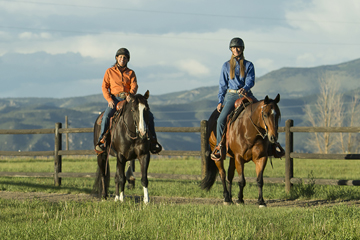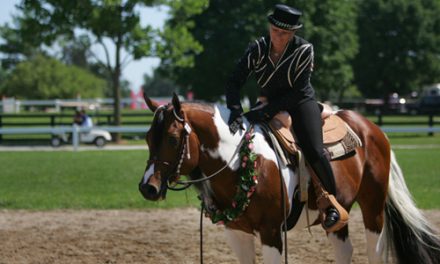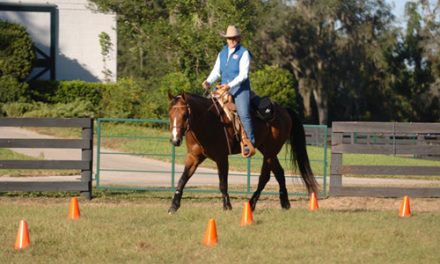Palm Partnership Training
Get Results You Can Use
 “Training Outside the Box” is just in time for spring training. The “box” refers to those confined areas, such as arenas and paddocks, where many riders have spent winter training time. Let’s get out of the “box” and learn to train outside for more fun, but always with safety in mind. This newsletter series is going to help you and your horse do just that!
“Training Outside the Box” is just in time for spring training. The “box” refers to those confined areas, such as arenas and paddocks, where many riders have spent winter training time. Let’s get out of the “box” and learn to train outside for more fun, but always with safety in mind. This newsletter series is going to help you and your horse do just that!
Why train outside? In 1976, I trained my first National and AQHA World Champion “Lecanto Raider” on the trails surrounding the beautiful Northwood community of Eagle River, Wisconsin. He was trained 85% on the trails, and only 15% in an arena.
There are three important reasons for training outside: (1) It helps maintain the horse’s awareness and attitude because he has new environments to experience; (2) It helps keep both the horse’s and the rider/trainer’s interest because being outside adds variety to lessons; and (3) If the rider needs to teach a horse to go forward, especially a horse that gets lazy and lethargic easily and requires effort to ‘stay forward,’ training outside is the best thing to do!
The most common question I am asked relates to training and trail riding outside. Riders are concerned about losing control of their horse, and what to do if the horse is disobedient, bucks, or rears. The rider gets fearful and apprehensive about getting hurt. We want to avoid these issues so riding and training outside remains fun and safe!
The answer to preventing these problems is recognizing and exercising the horse to release what I call the horse’s “inner energy.” Many riders do not realize that when they take their horse into a new environment, they will almost always experience their horse being overly sensitive and being higher strung in new surroundings. Riders tend to expect that the horse will work and perform in new surroundings in the same way as he does at home. They do not realize that a horse will nearly always be different in a new and different environment. This is especially true of horses that are not ‘seasoned’ – – those who have not become experts in going different places and traveling many miles over many years.
Just as importantly, many riders do not realize that any healthy, fit horse will have some level of ‘inner energy’ that must be released before he can concentrate on the task at hand. The level of ‘inner energy’ can vary among horses, but it is always there in high strung or sensitive horses, and lazy horses as well. When a horse has not released his ‘inner energy,’ he will be thinking ‘fast.’ Remember: You will be safe and you can teach a horse only if they are thinking ‘slow.’ You can recognize that a horse is thinking ‘fast’ if he is turning his head fast, moving his ears fast, and his movements are fast.
One of the best ways to help the horse release this inner energy is through what we call “forced exercise.” There are 3 types of forced exercise: (1) lunging, (2) liberty work, and (3) ponying. Of these three, the most important to master is lunging. (If you need a review of how to lunge, see Palm Partnership Training™ Newsletters #56-60.) Personally, I feel lunging is the most important form of forced exercise because you can use it anytime, at home or away. All you need is a good fitting halter, a cotton longe line, and a lunge whip. The lunge whip should have a minimum length of 3 feet with a tassle that is 1-2 feet longer than the whip part. The whip should end in a little “snapper.” This strong woven material helps make a snap/pop noise to encourage the horse to move away from it and to move forward.
Here are a few rules to follow when lunging. If the horse is already bridled and needs to be lunged, simply fit the halter over the bridle. Attach the lunge line either over the nose (for more response) or under the chin. A lunge line that ends in a chain will be more severe than a simple cotton line with a snap end. Before lunging (with a bridle on), it is very important to secure the reins so the horse cannot get them over his head, step on them, or get a leg between them. I’ll cover this issue in the “Your Next Step” section of this newsletter.
Before we start training outside the box, it is important to recognize and learn how to read a horse to determine if his inner energy and playfulness have been released. We’ll cover that in the next article.
Your Next Step…
When lunging with bridle on, always secure the reins. Place the halter over the bridle. Attach the lunge line, with or without chain end, to the horse’s halter. Do this by either threading the lunge line over the nose, to give more response, or under the chin.
If riding in Western tack, tie reins under the pommel bringing them through the hole under the pommel and tying a knot in them. Loop the knotted end over the saddle horn. Make sure that the reins are not secured so loose that the horse could put his head down with his nose on the ground, or get a leg through the reins. Be equally careful not to tie the reins too short, either. It will restrict the horse’s head carriage. If riding in English tack, the easiest way to handle the issue of the reins is just to take them off.





